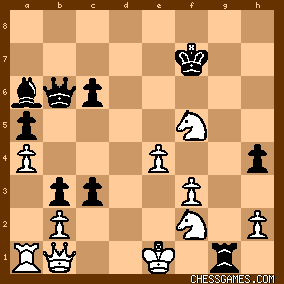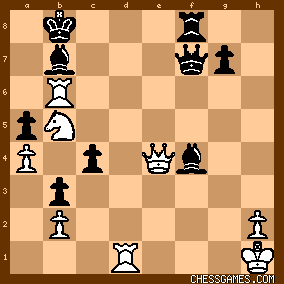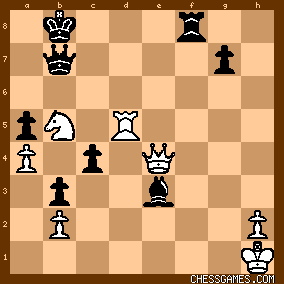|
< Earlier Kibitzing · PAGE 2 OF 2 ·
Later Kibitzing> |
| Mar-13-13 | | stacase: That was a fun romp. My first impulse was 23...Rxf3 but I didn't see all the way to an advantage for Black, but then there wasn't anything else. 21...Be1 is just too sweet! |
|
| Mar-13-13 | | morfishine: Black is down a piece; He will lose if the attack fails; <23...Rxf3 24.gxf3> Forced; but here, I already got side tracked and played <24...Rg8+> (instead of the text 24...Bc5) and continued <25.Ng3 h5 26.Kf1 h4 27.Nf5> and only now <27...Bc5> and got lost in my own complications thinking White needed to play <28.Nd1> (Though scary looking, 28.Rg2 is better) allowing <28...Nxf2 29.Bxf2 c3+ 30.Ke1 Bxf2+ 31.Nxf2 Rg1 mate>

click for larger view**********
PM(1): I played too many 'less than best' moves for Black PM(2): In 1992, I lost to GM Henley in a 15-board simul; I couldn't figure him out then, and couldn't figure him out here! |
|
| Mar-13-13 | | mistreaver: Wednsday. Black to play. Medium/Easy. 23.?
After looking at the position for some time, i found 2 candidates:
1)
The primitive approach
23... Bc5
24 Nxf6 Bxf2+
25 Kh1 Bxe1
26 Ng4 Nf2+
27 Nxf2 Qxf2
and black has mating threats.
2)
Something a bit more forcing:
23... Rxf3
24 gxf3 forced
24... Rg8+
25 Kf1 (else Nxf2+)
25... Nxe1
26 Qxe1, and now i wanted to play c3 dis ch forgetting that c3 is obstructed by a pawn. So i will stick
with my first line as main line, altough i feel there is something more forcing.
Time to check.
------------------
Ah, a synthesis of ideas. I was kinda on a right track, but the point is that black's rook has to eliminate white's light squared bishop before Bc5. However, even my line should win, altough game would dragg out for quite some time. Therefore 0.5/1 for today. |
|
| Mar-13-13 | | andyatchess: Attack the pinned piece, oh and nice finish. |
|
| Mar-13-13 | | dufferps: After 25. ... Bxf2, I think Schmidt could (should?) have played 26.Bxf2.
I can't find a winning line for black after 26.Bxf2. Black must then check the white king or lose his queen. Then, I think white can spoil the rook attack on the g-file with Ng3. |
|
| Mar-13-13 | | LucB: 27...Be1! was a nice move! |
|
| Mar-13-13 | | Simplification: <duffersps> After 26 Bxf2 black has a forced mate with Qxf2+ 27 Kh1 (Kh3 28 Bc8#) Qxf3+ 28 Kg1 Rg8+ 29 Ng3 Rxg3+ 30 hxg3 Qxg3+ 31 Kh1 (Kf1 32 Qf2#) Nf2# |
|
| Mar-13-13 | | kevin86: Black cuts off the queen and threatens mate...there is no defense that could save the game. |
|
| Mar-13-13 | | dufferps: Thanks, <Simplification> - I guess you and Henley would see that a Rook-sac on move 29. would force a win. I missed that. |
|
| Mar-13-13 | | MountainMatt: Missed it - played Bc5 a move too early. Oh well. |
|
| Mar-13-13 | | patzer2: Henley's desparado demolition sacrifice 17...Nxf2!? is interesting and complicated. With passive play he was probably lost, so he must have figured why not go for the gusto! Fritz 12 indicates White holds and wins after 17...Nxf2!? with the odd looking 19. Be1! (instead of the expected 19. Bf3?!). Play in this line might go 19. Be1! (avoiding 19. Bf3?! Ne5! and the game's active counterplay) 
click for larger view19...Bc5 20. Bf3 (20...Ne5? 21. Nxe6+  ) 20...Be3 21. Nxe6 Rxf3 22. gxf3 Kf7 23. Nd1 Bh6 24. Bc3 Kxe6 25. e5 Qc5 26. Qxh7 Nxe5 27. Kh1 Qd5 28. Bxe5 Qxe5 29. Nc3 Kd7 30. f4 Qe6 ) 20...Be3 21. Nxe6 Rxf3 22. gxf3 Kf7 23. Nd1 Bh6 24. Bc3 Kxe6 25. e5 Qc5 26. Qxh7 Nxe5 27. Kh1 Qd5 28. Bxe5 Qxe5 29. Nc3 Kd7 30. f4 Qe6 (30... Bxf4? 31. Rg1! Bh6? 32. Rf7+ Kd6 33. Ne4+ Kd5 34. Rd1+ Ke6 35. Qg6+ Qf6 36. Nc5+ Ke5 37.
Qe4#) 31. Re2 Qf6 32. Rae1 Rf8 33. Re7+ Kc8 34. Qe4 Bb7 35. Rd1 Bxf4 36. Nb5 Ba8 37. Re6 Qf7 38. Rxc6+ Kb8 (38... Bxc6 39. Qxc6+ Kb8 40. Rd7 Qxd7 41. Qxd7  ) ) 39. Rb6+ Bb7

click for larger view40. Rd5! Be3 41. Rxb7+ Qxb7

click for larger view42. Qe5+! (42. Qxe3?? Qxd5+  ) Ka8 43. Nc7+ Kb8 44. Ne6+ Kc8 45. Nxf8 Qf7 46. Qe6+ Qxe6 47. Nxe6 ) Ka8 43. Nc7+ Kb8 44. Ne6+ Kc8 45. Nxf8 Qf7 46. Qe6+ Qxe6 47. Nxe6  P.S.: Games like this are an excellent reminder Chess at the human level goes beyond deep computer calculations of "best play," especially in difficult and complicated positions where one player is more skilled or better prepared. |
|
| Mar-13-13 | | jrbleau: I first considered 23...Bc5, but given that W can take the f6R, I figured why not give up the exchange and open lines at the same time and came up with the right initial sequence of moves. |
|
| Mar-13-13 | | agb2002: Black is a knight down.
White threatens 24.Nxf6.
The first idea that comes to mind is 23... Bc5, trying to recover some material and eliminating some of the defenders of the white king: A) 24.Nxf6 Bxf2+
A.1) 25.Bxf2 Qxf2+ 26.Kh1 Kxf6 - + [N].
A.2) 25.Kf1 Bxe1 26.Ng4 Bxc3 (26... h4 27.Ne5+ Nxe5 (27... Kf6 28.Nd7+ + -; 27... Ke6 28.Nxd3 Bxc3 29.Nf4+ Ke5 30.bxc3 Kxf4 unclear) 28.Qxe1 Nd3 29.Qe2 - /+) 27.bxc3 h5 seems to win the knight due to the mate threat on f2. A.3) 25.Kh1 Bxe1 26.Ng4 Bxc3 27.bxc3 h5 28.Nh6+ Kg6 29.Nf5 Nf2+ 30.Kg1 Nxe4+ 31.Kh1 (31.Kf1 Qf2#) 31... Nf2+ 32.Kg1 Nd3+ 33.Kh1 Kxf5 - +. B) 24.Nd1 Nxe1
B.1) 25.Kf1 Bxf2 26.Nxf2 (26.Nxf6 c3+ 27.Be2 c2 28.Qc1 Bxe2+ 29.Kxe2 Qa6+ 30.Kxf2 (30.Kd2 Qd3#) 30... Nd3+ and 31... Nxc1, etc.) 26... Nc2 27.Nxf6 Kxf6 followed by Nxa1 - +. B.2) 25.Nxf6 Nd3 26.Nd7 Bxf2+ 27.Kh1 unclear.
The last line invites to play first 23... Rxf3 24.gxf3 Bc5 (24... Rg8+ 25.Kf1, but not 25.Kh1 Qxf2 26.Bxf2 Nxf2#): A) 25.Kf1 Bxf2, with the threat 26... Bxe1 and 27... Qf2#, looks winning. B) 25.Kf1 Bxf2 26.Bxf2 Qxf2 27.Qf1 Qxb2 looks disasterous for White. C) 25.Nd1 Nxe1 followed by Rg8 with a winning attack (26.Kf1 c3+; 26.e5 Nd3 followed by Bxf2, etc.). |
|
| Mar-13-13 | | Patriot: Material is even. White threatens 24.Nxc6 winning the exchange. There must be a way to take advantage of the pin. Meanwhile, why not control how to lose the exchange? 23...Rxf3 24.gxf3 Bc5 
I don't see a way for white to keep from losing material. |
|
| Mar-13-13 | | Patriot: <<morfishine>: Black is down a piece> Oops--You are right! Somehow I missed the extra knight for white. |
|
| Mar-13-13 | | morfishine: <Patriot> Well, you got the combination correct, so not counting the pieces wasn't that significant |
|
| Mar-13-13 | | Alex56171: If White had played 25. Nd1, the game would not have ended so soon and so brilliantly. |
|
| Mar-13-13 | | pericles of athens: When I'm playing white and black's queen is on b6, I think "careful!" everytime. But even more so if there's no pawn at f2 to protect. |
|
| Mar-13-13 | | Abdel Irada: <<•>Quantum entanglement?<•>> White is ahead on material and Black's king is exposed, but it is the white king that is imperiled thanks to the incoordination and passive placement of his forces. In a position in which both players are threatening to win an exchange, it is intuitively inviting to sacrifice the exchange actively, especially given the degree to which doing so stifles counterplay and opens lines for timely use. Therefore ... <<•> 23. ...Rxf3! 24. gxf3 ... >
Useful alternatives do not exist.
<<•> 24. ...Bxc3 25. bxc3, b2
26. Ra2, Qe3  > >
White is in a deadly bind. He can't defend his bishop, and he can't move it without losing his rook on f2 with check and mate soon to follow. I could analyze the two continuations, 27. Kf1 and 27. Rxb2, but with the black rook poised to enter the fray from g8 and the bishop from h3 via c8, I see little point. When one party has the other tied up like a pretzel as designed by M.C. Escher, victory is a matter of when, not if. |
|
| Mar-13-13 | | Abdel Irada: Interesting. I'd considered 24. ...Bc5, but thought my solution looked more convincing. Now, looking at the game, I'm not sure which continuation is more effective. |
|
| Mar-13-13 | | Patriot: <Abdel Irada> It's more like "spooky entanglement" since one of black's knight's is a ghost (which I failed to notice). <Now, looking at the game, I'm not sure which continuation is more effective.> In your line, 27.Raxb2 is winning for white according to Houdini. |
|
| Mar-13-13 | | Patriot: I should have mentioned 27.Raxb2! Nxb2 28.Bd2 - a very sneaky move! |
|
| Mar-13-13 | | Abdel Irada: Argh. I now begin to see a way for White to wriggle out against my continuation in spite of all appearances. I guess the brute-force text is the way to go after all. :-/ |
|
| Mar-13-13 | | Abdel Irada: Houdini was well named. That continuation is the one I found in further study (although it all depends on the timely retreat 29. Ng3). |
|
| Mar-14-13 | | Patriot: <Abdel Irada> I prefer brute-force any day if possible, because it doesn't leave much wriggle room. But 24...Bxc3 is pretty darn forcing. The simple pattern of a "pin it and win it" won out this time. And sometimes the obviously simple pattern doesn't work, where it may require something counter-intuitive or a simple capture somewhere (as in Bxc3). I don't recall which day it was but the position with Fischer as white played Nxc6 which seemed counter to the pattern I was seeing. A quick glance told me that Nd5 was the winning pattern but that failed after a little proof. |
|
 |
|
< Earlier Kibitzing · PAGE 2 OF 2 ·
Later Kibitzing> |





































